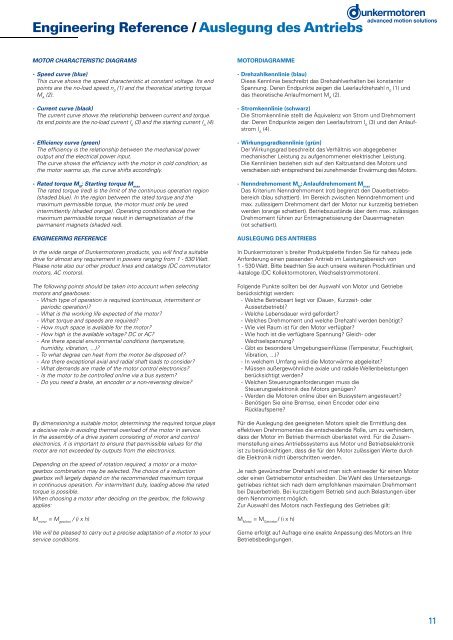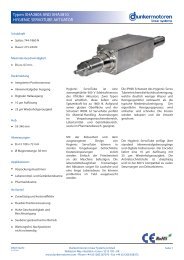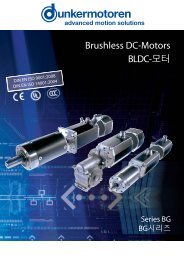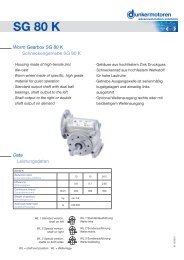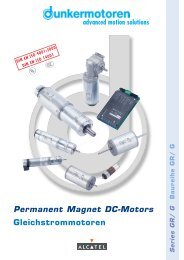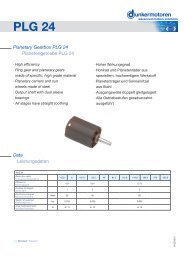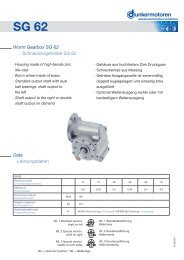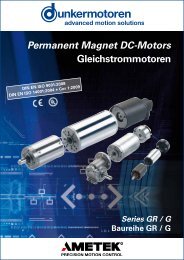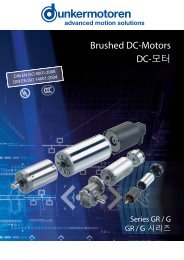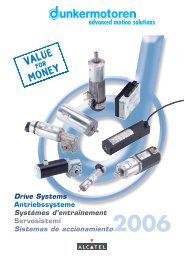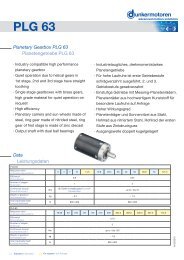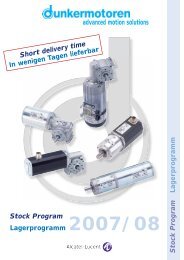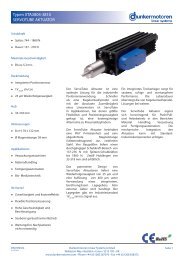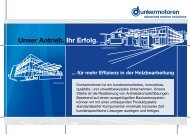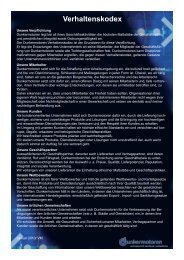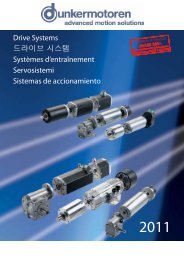Bürstenlose Gleichstrommotoren Baureihe BG - Dunkermotoren
Bürstenlose Gleichstrommotoren Baureihe BG - Dunkermotoren
Bürstenlose Gleichstrommotoren Baureihe BG - Dunkermotoren
Create successful ePaper yourself
Turn your PDF publications into a flip-book with our unique Google optimized e-Paper software.
Engineering Reference / Auslegung des Antriebs<br />
MOTOR CHARACTERISTIC DIAGRAMS<br />
- Speed curve (blue)<br />
This curve shows the speed characteristic at constant voltage. Its end<br />
points are the no-load speed n 0<br />
(1) and the theoretical starting torque<br />
M A<br />
(2).<br />
- Current curve (black)<br />
The current curve shows the relationship between current and torque.<br />
Its end points are the no-load current I 0<br />
(3) and the starting current I A<br />
(4).<br />
- Efficiency curve (green)<br />
The efficiency is the relationship between the mechanical power<br />
output and the electrical power input.<br />
The curve shows the efficiency with the motor in cold condition; as<br />
the motor warms up, the curve shifts accordingly.<br />
MOTORDIAGRAMME<br />
- Drehzahlkennlinie (blau)<br />
Diese Kennlinie beschreibt das Drehzahlverhalten bei konstanter<br />
Spannung. Deren Endpunkte zeigen die Leerlaufdrehzahl n 0<br />
(1) und<br />
das theoretische Anlaufmoment M A<br />
(2).<br />
- Stromkennlinie (schwarz)<br />
Die Stromkennlinie stellt die Äquivalenz von Strom und Drehmoment<br />
dar. Deren Endpunkte zeigen den Leerlaufstrom I 0<br />
(3) und den Anlaufstrom<br />
I A<br />
(4).<br />
- Wirkungsgradkennlinie (grün)<br />
Der Wirkungsgrad beschreibt das Verhältnis von abgegebener<br />
mechanischer Leistung zu aufgenommener elektrischer Leistung.<br />
Die Kennlinien beziehen sich auf den Kaltzustand des Motors und<br />
verschieben sich entsprechend bei zunehmender Erwärmung des Motors.<br />
- Rated torque M N<br />
; Starting torque M max<br />
The rated torque (red) is the limit of the continuous operation region<br />
(shaded blue). In the region between the rated torque and the<br />
maximum permissible torque, the motor must only be used<br />
intermittently (shaded orange). Operating conditions above the<br />
maximum permissible torque result in demagnetization of the<br />
permanent magnets (shaded red).<br />
ENGINEERING REFERENCE<br />
In the wide range of <strong>Dunkermotoren</strong> products, you will find a suitable<br />
drive for almost any requirement in powers ranging from 1 - 530 Watt.<br />
Please note also our other product lines and catalogs (DC commutator<br />
motors, AC motors).<br />
The following points should be taken into account when selecting<br />
motors and gearboxes:<br />
- Which type of operation is required (continuous, intermittent or<br />
periodic operation)<br />
- What is the working life expected of the motor<br />
- What torque and speeds are required<br />
- How much space is available for the motor<br />
- How high is the available voltage DC or AC<br />
- Are there special environmental conditions (temperature,<br />
humidity, vibration, ...)<br />
- To what degree can heat from the motor be disposed of<br />
- Are there exceptional axial and radial shaft loads to consider<br />
- What demands are made of the motor control electronics<br />
- Is the motor to be controlled online via a bus system<br />
- Do you need a brake, an encoder or a non-reversing device<br />
By dimensioning a suitable motor, determining the required torque plays<br />
a decisive role in avoiding thermal overload of the motor in service.<br />
In the assembly of a drive system consisting of motor and control<br />
electronics, it is important to ensure that permissible values for the<br />
motor are not exceeded by outputs from the electronics.<br />
Depending on the speed of rotation required, a motor or a motorgearbox<br />
combination may be selected. The choice of a reduction<br />
gearbox will largely depend on the recommended maximum torque<br />
in continuous operation. For intermittent duty, loading above the rated<br />
torque is possible.<br />
When choosing a motor after deciding on the gearbox, the following<br />
applies:<br />
M motor<br />
= M gearbox<br />
/ (i x h)<br />
We will be pleased to carry out a precise adaptation of a motor to your<br />
service conditions.<br />
- Nenndrehmoment M N<br />
; Anlaufdrehmoment M max<br />
Das Kriterium Nenndrehmoment (rot) begrenzt den Dauerbetriebsbereich<br />
(blau schattiert). Im Bereich zwischen Nenndrehmoment und<br />
max. zulässigem Drehmoment darf der Motor nur kurzzeitig betrieben<br />
werden (orange schattiert). Betriebszustände über dem max. zulässigen<br />
Drehmoment führen zur Entmagnetisierung der Dauermagneten<br />
(rot schattiert).<br />
AUSLEGUNG DES ANTRIEBS<br />
In <strong>Dunkermotoren</strong>´s breiter Produktpalette finden Sie für nahezu jede<br />
Anforderung einen passenden Antrieb im Leistungsbereich von<br />
1 - 530 Watt. Bitte beachten Sie auch unsere weiteren Produktlinien und<br />
-kataloge (DC Kollektormotoren, Wechselstrommotoren).<br />
Folgende Punkte sollten bei der Auswahl von Motor und Getriebe<br />
berücksichtigt werden:<br />
- Welche Betriebsart liegt vor (Dauer-, Kurzzeit- oder<br />
Aussetzbetrieb)<br />
- Welche Lebensdauer wird gefordert<br />
- Welches Drehmoment und welche Drehzahl werden benötigt<br />
- Wie viel Raum ist für den Motor verfügbar<br />
- Wie hoch ist die verfügbare Spannung Gleich- oder<br />
Wechselspannung<br />
- Gibt es besondere Umgebungseinflüsse (Temperatur, Feuchtigkeit,<br />
Vibration, ...)<br />
- In welchem Umfang wird die Motorwärme abgeleitet<br />
- Müssen außergewöhnliche axiale und radiale Wellenbelastungen<br />
berücksichtigt werden<br />
- Welchen Steuerungsanforderungen muss die<br />
Steuerungselektronik des Motors genügen<br />
- Werden die Motoren online über ein Bussystem angesteuert<br />
- Benötigen Sie eine Bremse, einen Encoder oder eine<br />
Rücklaufsperre<br />
Für die Auslegung des geeigneten Motors spielt die Ermittlung des<br />
effektiven Drehmomentes die entscheidende Rolle, um zu verhindern,<br />
dass der Motor im Betrieb thermisch überlastet wird. Für die Zusammenstellung<br />
eines Antriebssystems aus Motor und Betriebselektronik<br />
ist zu berücksichtigen, dass die für den Motor zulässigen Werte durch<br />
die Elektronik nicht überschritten werden.<br />
Je nach gewünschter Drehzahl wird man sich entweder für einen Motor<br />
oder einen Getriebemotor entscheiden. Die Wahl des Untersetzungsgetriebes<br />
richtet sich nach dem empfohlenen maximalen Drehmoment<br />
bei Dauerbetrieb. Bei kurzzeitigem Betrieb sind auch Belastungen über<br />
dem Nennmoment möglich.<br />
Zur Auswahl des Motors nach Festlegung des Getriebes gilt:<br />
M Motor<br />
= M Getriebe<br />
/ (i x h)<br />
Gerne erfolgt auf Aufrage eine exakte Anpassung des Motors an Ihre<br />
Betriebsbedingungen.<br />
11


